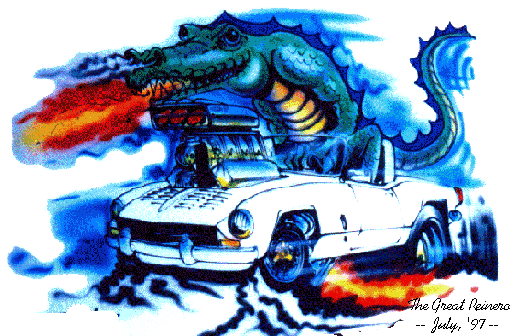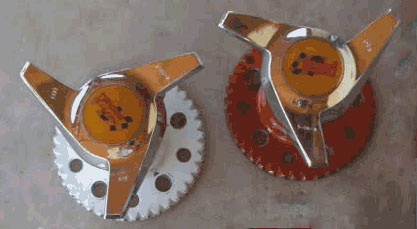
New lower a-arm frame mounts were used to replace the 48 year old originals. In fact all of the nuts, bolts, washers were replaced with new grade 8 hardware. From those holding the suspension pedestals to those securing the a-arms. Polyurethane bushings were used to replace the original, now squashed, original rubber bushings.
The above slide show displays the assembly of the front suspension. The slideshow controls allow for automatic or manual display of photos. The photos are linked, in order, to the following assembly steps. The driver's side suspension is used as the demonstration:
- Photos 1 & 2 - Installation of the Spitfire spring cap. The spring cap is the mounting position for the new shock absorbers. Photo 2 shows the bottom of the cap - the bolt heads, towards the center of the cap, had to be ground to allow the top of the shock to sit flush against the cap.
-
Photo 3 - Mounting of the lower a-arm. The a-arm frame mounts used to connect the
a-arm to the frame are new. The bolts to mount the a-arm to the frame mounts were replaced with new
grade 8 hardware as well as the use of polyurethane bushings. The new lower ball joint (stock 1970 Chevy Nova)
are pressed in, the ball joint's zerk fitting is installed, and the ball joint has been lubricated.
The machine shop that I patronized during the suspension upgrades stated that they could create CNC aluminum billet lower a-arms that would duplicate the strength and utility of the existing ones, BUT LOOK EXTREMELY COOL! Of course I would have to take out a mortgage on my house to finance them. - Photo 4 - Mounting of the Canley Classics upper a-arm. The bolts to mount the a-arm to the suspension pedestal were replaced with new grade 8 hardware as well as the use of polyurethane bushings. Note the adjustable ball joint for setting camber.
- Photo 6 - Installation of the AFCO aluminum billet shock absorbers and coil-over springs. The shock's upper mount fits into the stock Spitfire spring cap in the same manner as the stock shocks. Unlike the Spitfire stock springs, the new springs are fully mounted on the shock and held by upper and lower spring seats . The uncompressed springs are 10 inches in length and do not need to be compressed for installation. The springs are pre-compressed once they have been mounted on the vehicle. This made their installation simple. The lower shock mounts require a 1/2 inch bolt instead of the 7/16 normally used on a Spitfire. Also, the billet shocks have more material around the mount necessitating the rectangular relief hole cut in the bottom plate of the lower a-arm. The shocks were extremely easy to install.
- Photo 6 - Installation of the new Chevy Nova spindles. The top taper of the spindle had to be re-drilled to match the taper on the upper ball joint. The spindle was attached to the lower ball joint and then the floor jack was used to raise the lower a-arm to attach the spindle to the upper ball joint. The nuts were torqued to specs and all was ready to proceed to the next step.
- Photo 7 - The steering arm was put in place with flat head machine screws. Hex head hardware made contact with the lower a-arm thereby interfering with the turn radius. The nuts were not added at this time since the same bolts are used to attach the brake's splash shield and caliper bracket.
- Photo 8 - Installing the brake's splash shield and caliper bracket. The caliper bracket is put in place first and the splash shield is mounted on top of it. With both shield and bracket in place, lock washers and nuts were put on the bolts and the top bolt was inserted. All were tightened to spec. and ready for the disc/hub and caliper with brake pads.
- Photos 9, 10, & 11 - Installing the disc/hub. I had my local auto shop, The Auto House of Clovis, CA, that does oil changes on the Spitfire, pre-lube the tapered hub bearings when they pressed in the lower ball joints. So all I had to do is install the rear bearing, tap in the seal, grease the axle, and set the disc/hub in place. Then install the outer bearing with keyed washer and tighten the nut to spec.
- Photos 12 & 13 - Installing the disc brake caliper. The caliper was shipped uncoated. In order to have it powder coated, all of the seals that had been preinstalled would have to be removed. I opted to paint it with a special ceramic paint just for brake calipers - brake fluid resistant. Colors were short on choice so I opted for red rather than black or green. It does clash with the Bengal Orange of the powder coating, but they are mounted on black brackets. Prior to installing the calipers, I installed the banjo end of the braided steel brake line to insure it was torqued correctly. The caliper was put in place on the bracket and the two caliper bolts inserted and tightened. With both calipers installed the brake lines were re-connected and the system drained of the old brake fluid and filled with new high temp, Dot 3 brake fluid and bled.
-
Photo 14 & 15 - Re-installing the knock-off conversion hub and wheel. The Zenith/Dayton knock-off adaptor
was installed on the disc hub and the wire wheel and tire was remounted. The photo of the adaptor was
taken off of the web since I forgot to photograph mine prior to installation. Mine aren't so pretty.
The installation is complete.

Initial wheel alignment was accomplished with the same piece of angle iron, carpenter's laser level, and tape measure used to accomplish the rear wheel alignment. The principal was the same - tie wrap the angle iron to the wheel (through the spokes), make sure it is level, set the magnetic level to the iron, and point it straight along the angle iron. Measure where the laser beam hits the tape when placed in the front and rear portions of the rear wheel rim. Make sure that they are the same reading. Then drive it to the professionals to align.